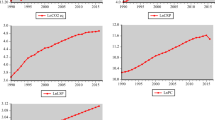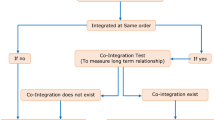Abstract
The objective of this research is to discuss the relationship between the growth of livestock and the environmental impact it generates in Colombia. For this, data were extracted from the FAO STAT for the period of 1961 to 2017. The livestock inventory has had a significant growth during the last 50 years. This has generated environmental exposure and the release of carbon, sequestered by continuous deforestation performed in the practice of extensive livestock. Recurring to vector error correction models, we observed the existence of long-term relations between CO2 emissions from dairy cattle and emissions from slaughtered cattle, deforestation, pastures, and forest development. Changes in CO2 emissions from dairy cattle tend to be anticipated by changes in CO2 emissions from the other analyzed sources, which prove how the current investment in dairy cattle results from the accumulated debates in Colombia regarding the different sources of livestock emissions.




Similar content being viewed by others
Availability of data and materials
Not applicable
Notes
Following Neuhaus (2006, p.122), we must conclude that under a valid cointegration relationship, there is no serious issue with multicollinearity or endogeneity among the regressors. However, we ran tests on the multicollinearity of the independent variables of the equations exhibited here and obtained variance inflation factors below 10 (favoring the hypothesis of non-multicollinearity). We also ran Durbin-Hausman-Hu tests on our six long-term equations and determined an absence of endogenous threats. Full details are available upon request.
For this statistics, we considered the values obtained for the Schwarz’s Bayesian information criterion (SBIC). Full results are available upon request.
References
Burbano H (2016) El suelo y su relación con los servicios ecosistémicos y la seguridad alimentaria. Rev Ciênc Agron 33(2):117–124. https://doi.org/10.22267/rcia.163302.58
Bustamante MMC, Nobre CA, Smeraldi R, Aguiar APD, Barioni LG, Ferreira LG, Longo K, May P, Pinto AS, Ometto JPHB (2012) Estimating greenhouse gas emissions from cattle raising in Brazil. Clim Chang 115:559–577. https://doi.org/10.1007/s10584-012-0443-3
Desjardins R, Worth D, Vergé X, Maxime D, Dyer J, Cerkowniak D (2012) Carbon footprint of beef cattle. Sustainability 4:3279–3301. https://doi.org/10.3390/su4123279
FAO STAT (2020) Various indicators. Downloaded from http://www.fao.org/faostat/es/#data. Accessed 23 July 2020
Fritts R (2018) Tropical deforestation now emits more CO2 than the EU. Global Forest Reporting Network. Mongabay 18 October 2018. Available through https://news.mongabay.com/2018/10/tropical-deforestation-now-emits-more-co2-than-the-eu/. Accessed 23 July 2020
Grau R, Aide M (2008) Globalization and land-use transitions in Latin America. Ecol Soc 13(2)
IDEAM, Instituto de Hidrología, Meteorología y Estudios Ambientales (2019) BOLETÍN DE DETECCIÓN TEMPRANA DE DEFORESTACIÓN, tercer trimestre (JULIO – SEPT) 2019
IGAC, Instituto Geográfico Agustín Codazzi (2010) Estudio de los conflictos de uso del territorio colombiano. Bogotá, Colombia
Krolzig H, Hendry D (2000) Computer automation of general-to-specific model selection procedures. J Econ Dyn Control 25:831–866
McAlpine C, Etter A, Fearnside PM, Seabrook L, Laurance WF (2008) Increasing world consumption of beef as a driver of regional and global change: A call for policy action based on evidence from Queensland (Australia),Colombia and Brazil. Glob Environ Chang 19:21–33
Moss A, Jouany J-P, Newbold J (2000) Methane production by ruminants: its contribution to global warming. Ann Zootech 49:231–253
Mourao P (2015) The complex relation between the Belarusian trade openness and the agricultural sector. Land Use Policy 43(1):74–81
Mourao PR, Domingues Martinho V (2017) Portuguese agriculture and the evolution of greenhouse gas emissions—can vegetables control livestock emissions? Environ Sci Pollut Res 24:16107–16119. https://doi.org/10.1007/s11356-017-9257-1
Proops JLR, Faber M, Wagenhals G (1993) Decomposing the Rate of Change of CO2 Emissions. In: Reducing CO2 Emissions. Springer, Berlin, Heidelberg
Seo N, McCarl BA, Mendelsohn R (2010) From beef cattle to sheep under global warming? An analysis of adaptation by livestock species choice in South America. Ecol Econ 69:2486–2494
Ziegler M (2019) Reducing CO2 Emissions. MTZ Worldwide 80:16–17. https://doi.org/10.1007/s38313-018-0159-5
Funding
This paper is financed by National Funds of the FCT—Portuguese Foundation for Science and Technology within the project «UIDB/03182/2020».
Author information
Authors and Affiliations
Contributions
All the 3 Authors (David Roberto Patiño Domínguez; Nadja Simone Menezes Nery de Oliveira; Paulo Reis Mourao) have contributed to the different phases of this research.
Corresponding author
Ethics declarations
Conflict of interest
Not applicable
Ethical approval
Not applicable
Consent to participate
Not applicable
Consent to publish
Not applicable
Additional information
Responsible Editor: Philippe Garrigues
Publisher’s note
Springer Nature remains neutral with regard to jurisdictional claims in published maps and institutional affiliations.
Rights and permissions
About this article
Cite this article
Patiño-Domínguez, D.R., de Oliveira, N.S.M.N. & Mourao, P.R. Cointegrated land use and CO2 emissions—the silent Columbian cattle revolution. Environ Sci Pollut Res 28, 11030–11039 (2021). https://doi.org/10.1007/s11356-020-11133-z
Received:
Accepted:
Published:
Issue Date:
DOI: https://doi.org/10.1007/s11356-020-11133-z




